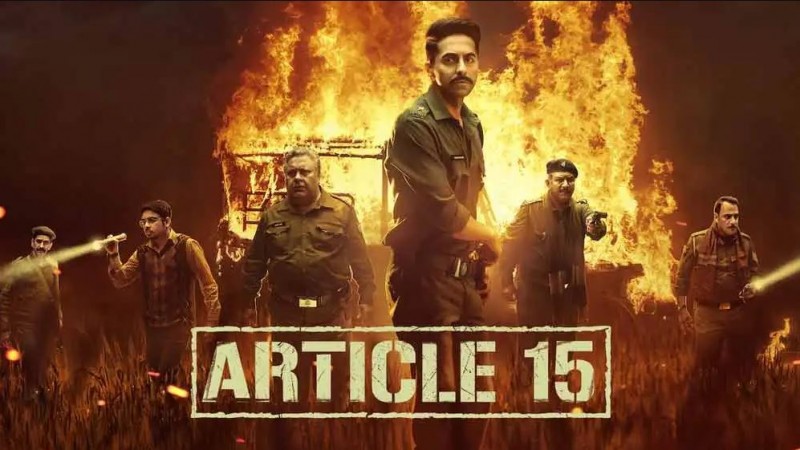
Some of the most important social issues have frequently been examined and brought to light through the lens of cinema. One such movie that serves as a moving example of this power is "Article 15." Anubhav Sinha's 2019 film, which explores the harsh realities of Indian society by drawing inspiration from a number of real-life events, was well received when it was released. While not based on a single specific incident, "Article 15" uses a variety of incidents, such as the allegations of gang rape in Badaun in 2014 and the flogging incident in Una in 2016, to weave a compelling tale that highlights the pervasive caste-based discrimination in India.
It's imperative to give a quick summary of "Article 15" before delving into the movie's real-life inspirations. The story of Ayan Ranjan, an idealistic Indian Police Service officer stationed in a remote Uttar Pradesh village, is followed in the film, which stars Ayushmann Khurrana. When he takes over a police station in Lalgaon, a city that is sharply divided along caste lines, he is forced to deal with the bleak realities of caste-based discrimination.
As Ayan becomes involved in a case involving the disappearance of two young Dalit (lower-caste) girls, the plot of the movie develops. Due to caste prejudices, the local government is hesitant to conduct a thorough investigation. As Ayan digs deeper into the case, he exposes a web of injustice, brutality, and corruption that the dominant upper-caste elite has been committing against the oppressed Dalit community. The narrative is driven by Ayan's unrelenting search for justice, and the movie effectively highlights the systemic oppression that exists in Indian society.
While "Article 15" does not directly mimic any particular incident, it is heavily influenced by a number of actual occurrences that serve as sobering reminders of India's pervasive caste-based discrimination.
The 2014 Badaun gang rape allegations are among the most well-known events that shaped the movie's plot. Two teenage Dalit girls were discovered hanging from a tree in Badaun, Uttar Pradesh, in this horrifying incident. Initial police inquiries ruled it out as a suicide case, but later inquiries turned up evidence of a horrifying gang rape and murder.
The local authorities' indifference, carelessness, and caste-based bias are depicted in the movie as "Article 15" does. Ayan's commitment to finding the truth and enforcing justice is comparable to the efforts made by activists and investigative journalists to seek justice for the Badaun case victims.
The 2016 Una flogging incident in Gujarat also had a significant impact on the storyline of the movie. Self-described cow protectors publicly humiliated and beat four Dalit men for skinning a dead cow. The incident sparked widespread outrage and demonstrations against discrimination and caste-based violence.
The depiction of violence against Dalits and the perpetrators' sense of impunity in "Article 15" is similar to what happened in Una. The movie asks whether those in positions of authority were also complicit, echoing the outrage among the public and the demands for justice that followed the Una incident.
In addition to highlighting these particular incidents, "Article 15" also sheds light on the widespread caste-based discrimination that still exists in different regions of India. It illustrates how the caste system continues to have an impact on all aspects of life, including access to justice, employment opportunities, and educational opportunities.
The stark differences in living conditions, access to necessities, and the pervasive sense of superiority among upper-caste communities are all depicted in the movie. "Article 15" creates a microcosm of Indian society where the oppressed and marginalised fight to be free from the chains of prejudice through its characters and their interactions.
"Article 15" is more than just a film; it is a strong mirror held up to Indian society, reflecting its most unsettling and obscene truths. The movie goes beyond merely recounting various real-life incidents, such as the allegations of gang rape in Badaun in 2014 and the flogging of Una in 2016. It incorporates these sources of inspiration into a gripping story that delves into the depths of caste-based prejudice, corruption, and injustice that still afflict the country.
"Article 15" represents the possibility of change for those working within the system to uphold justice and equality through the persona of Ayan Ranjan. The movie serves as a wake-up call, urging society to address the deeply ingrained biases and prejudices that support caste-based discrimination.
"Article 15" is a potent cinematic masterpiece that challenges viewers to reflect and work towards a more just and equitable society. It not only entertains but also educates and entertains while doing so. It serves as a reminder that, despite the fact that the movie is a work of fiction, the harsh realities it depicts are all too real and call for our attention and action.
'Khule-Aam' Marks the Final Chapter of Guru Dutt Productions
The Unconventional Musical Shift in 'Baharen Phir Bhi Aayengi'